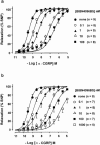BIBN4096BS is a potent competitive antagonist of the relaxant effects of alpha-CGRP on human temporal artery: comparison with CGRP(8-37)
- PMID: 11976276
- PMCID: PMC1762122
- DOI: 10.1038/sj.bjp.0704682
BIBN4096BS is a potent competitive antagonist of the relaxant effects of alpha-CGRP on human temporal artery: comparison with CGRP(8-37)
Abstract
Release of CGRP during migraine may produce harmful dilatation of cranial arteries, thereby possibly causing pain. We have compared the antagonism by BIBN4096BS and CGRP(8-37) of the relaxant effects of alpha-CGRP on rings of human temporal artery. alpha-CGRP relaxed the arteries precontracted with 9 - 24 mM KCl (-logEC50=9.4) nearly as efficaciously as sodium nitroprusside (10 microM). BIBN4096BS (0.1 - 100 nM) antagonized the effects of alpha-CGRP in surmountable manner with slopes of Schild-plots not different from unity. -LogKB values of 10.1 and 10.4 were estimated for BIBN4096BS when administered before or during the KCl-contracture respectively. BIBN4096BS (1 microM) did not modify the relaxant effects of papaverine and sodium nitroprusside. CGRP(8-37) (1 - 10 microM) antagonized the effects of alpha-CGRP in a surmountable manner with slopes of Schild-plots not different from unity. -LogKB values of 6.6 and 6.7 were estimated for CGRP(8-37) administered before or during the KCl-contracture respectively. The high affinity of BIBN4096BS for CGRP receptors of human temporal artery makes it an excellent tool to explore the hypothesis of CGRP-evoked cerebral vasodilation in migraine.
Figures






Similar articles
-
BIBN4096BS and CGRP(8-37) antagonize the relaxant effects of alpha-CGRP more than those of beta-CGRP in human extracranial arteries.Naunyn Schmiedebergs Arch Pharmacol. 2005 May;371(5):383-92. doi: 10.1007/s00210-005-1064-4. Epub 2005 Jun 28. Naunyn Schmiedebergs Arch Pharmacol. 2005. PMID: 15983761
-
Characterisation of CGRP receptors in the human isolated middle meningeal artery.Life Sci. 2006 Jun 13;79(3):265-71. doi: 10.1016/j.lfs.2006.01.003. Epub 2006 Feb 3. Life Sci. 2006. PMID: 16458930
-
Efficacy of the non-peptide CGRP receptor antagonist BIBN4096BS in blocking CGRP-induced dilations in human and bovine cerebral arteries: potential implications in acute migraine treatment.Neuropharmacology. 2002 Mar;42(4):568-76. doi: 10.1016/s0028-3908(02)00008-4. Neuropharmacology. 2002. PMID: 11955527
-
The preclinical pharmacology of BIBN4096BS, a CGRP antagonist.Cardiovasc Drug Rev. 2005 Spring;23(1):31-42. doi: 10.1111/j.1527-3466.2005.tb00155.x. Cardiovasc Drug Rev. 2005. PMID: 15867946 Review.
-
Development and potential of non-peptide antagonists for calcitonin-gene-related peptide (CGRP) receptors: evidence for CGRP receptor heterogeneity.Biochem Soc Trans. 2002 Aug;30(4):468-73. doi: 10.1042/bst0300468. Biochem Soc Trans. 2002. PMID: 12196117 Review.
Cited by
-
A Pharmacological Review of Calcitonin Gene-Related Peptide Biologics and Future Use for Chronic Pain.Cureus. 2023 Feb 17;15(2):e35109. doi: 10.7759/cureus.35109. eCollection 2023 Feb. Cureus. 2023. PMID: 36945265 Free PMC article. Review.
-
The potent calcitonin gene-related peptide receptor antagonist, telcagepant, does not affect nitroglycerin-induced vasodilation in healthy men.Br J Clin Pharmacol. 2011 May;71(5):708-17. doi: 10.1111/j.1365-2125.2010.03869.x. Br J Clin Pharmacol. 2011. PMID: 21480950 Free PMC article. Clinical Trial.
-
CGRP receptor antagonism and migraine.Neurotherapeutics. 2010 Apr;7(2):164-75. doi: 10.1016/j.nurt.2010.02.004. Neurotherapeutics. 2010. PMID: 20430315 Free PMC article. Review.
-
Calcitonin gene-related peptide (CGRP) receptor antagonists in the treatment of migraine.CNS Drugs. 2010 Jul;24(7):539-48. doi: 10.2165/11534920-000000000-00000. CNS Drugs. 2010. PMID: 20433208 Free PMC article.
-
Gel-forming antagonist provides a lasting effect on CGRP-induced vasodilation.Front Pharmacol. 2022 Dec 8;13:1040951. doi: 10.3389/fphar.2022.1040951. eCollection 2022. Front Pharmacol. 2022. PMID: 36569288 Free PMC article.
References
-
- BÖHME E., GRAF H., SCHULTZ G. Effects of sodium nitroprusside and other smooth muscle relaxants on cyclic GMP formation in smooth muscle and platelets. Advances Cyclic Nucleotide Research. 1978;9:131–143. - PubMed
-
- CHASIN M., HARRIS D.N. Inhibitors and activators of cyclic nucleotide phosphodiesterases. Advances Cyclic Nucleotide Research. 1976;7:223–264. - PubMed
-
- CHIBA T., YAMAGUCHI A., YAMATANI T., NAKAMURA A., MORISHITA T., INUI T., FUKASE M., NODA T., FUJITA T.Calcitonin gene-related peptide receptor antagonist human CGRP-(8-37) Am. J. Physiol. 1989256E331–E335.(Endocrinol. Metab. 19 - PubMed
-
- DEMESY-WAELDELE F., STOCLET J.C. Effect of papaverine on cyclic nucleotide levels in the isolated rat aorta. Eur. J. Pharmacol. 1977;46:63–66. - PubMed
Publication types
MeSH terms
Substances
LinkOut - more resources
Full Text Sources
Other Literature Sources
Research Materials

